|
Act Curtain:
|
See "Grand Drape"
|
|
AEA:
|
Actors' Equity Association – The union representing
actors and stage managers in the United States.
|
|
Alternating Current:
|
Electricity quickly alternating directions through a circuit.
The frequency with which this alternation occurs was once called
"Cycles per Second" (CPS), but now is referred to as Hertz,
abbreviated "Hz". In America, the standard is 60 Hz.
In Europe, the standard is 50HZ.
|
|
Amperes (or Amps):
|
The measurement of current. One ampere is
6.241×1018 electrons (or one coulomb) per second.
|
|
Apron:
|
The stage area which is downstage of the proscenium arch.
|
|
Arena Stage:
|
A stage with the audience surrounding it on all four sides.
|
Autofollow:
|
A cue which is automatically run as soon as the preceding cue
is complete.
|
|
Batten:
|
A horizontal pipe or strip of wood, usually as wide as, or wider than,
the width of the stage, hung overhead. Battens which run upstage/downstage,
as opposed to side to side, are referred to as "tabs".
|
|
Beam Angle:
|
The central portion of the cone of light, in which the intensity does not fall below 50% of maximum.
See Photometrics.
|
|
Beamlight (or Beam Projector):
|
A lighting fixture with a large parabolic reflector and no lens.
Often used with low voltage lamps (e.g.: 24V, 1000W) Casts
very intense nearly parallel beam. Historically, these were used frequently in
opera and musicals as a soft edged follow spot.
|
|
Bench Focus:
|
The process of adjusting the lamp socket, in an ellipsoidal reflector spotlight, so that the field of light is
even, with no "hot" spots.
|
|
Black Wrap TM:
|
A flexible matte black aluminum used to mask light leaks
and shape beams of light. Although often used as a generic
term, "Black Wrap" is a trade mark of GAMPRODUCTS, Inc.
Rosco makes a similar product called "Cinefoil".
|
|
Blacklight:
|
Ultra-violet light discharge lamp. Most common are actually
 fluorescent tubes, but unlike the fluorescent lights in your office or
classroom, the phosphor on the envelope emits light
in the near ultraviolet range rather than white light. Other
types include high intensity discharge lamps.
fluorescent tubes, but unlike the fluorescent lights in your office or
classroom, the phosphor on the envelope emits light
in the near ultraviolet range rather than white light. Other
types include high intensity discharge lamps.

Blacklights cause specially-treated surfaces to fluoresce
while in the absence of visible light, absorptive surfaces
tend to disappear.
|
|
Boom:
|
A vertically-mounted lighting position, usually mounted to
a wall or threaded into a base or flange on the floor. When
booms are mounted downstage of the proscenium, they are
known as box booms.
|
|
Borderlight:
|
See "X-Ray"
|
|
C-Clamp:
|
See "pipe clamp"
|
|
Candela:
|
Photometric unit describing the amount of light emitted from a light source.
|
|
Centerline:
|
An imaginary DS/US line that bisects the stage, usually labeled with
symbol like this:

|
|
Channel:
|
A control path that allows the console to vary the output
level of one or more dimmers or other devices. The channel
can be physical (controlled by a button, switch or slider)
or virtual, (controlled by a numeric keypad).
|
|
Channel Hookup (or
Switchboard Hookup):
|
A spreadsheet listing each fixture in the show with all its relevant
information, including, color, template, accessories, dimmer,
circuit, channel, wattage, and purpose. The channel hookup is
arranged in order of channel number.
|
|
Chromatic Aberration:
|
A type of distortion in which a lens fails to focus all colors to the
same point, resulting in a field of light which looks like this
(exaggerated for effect):
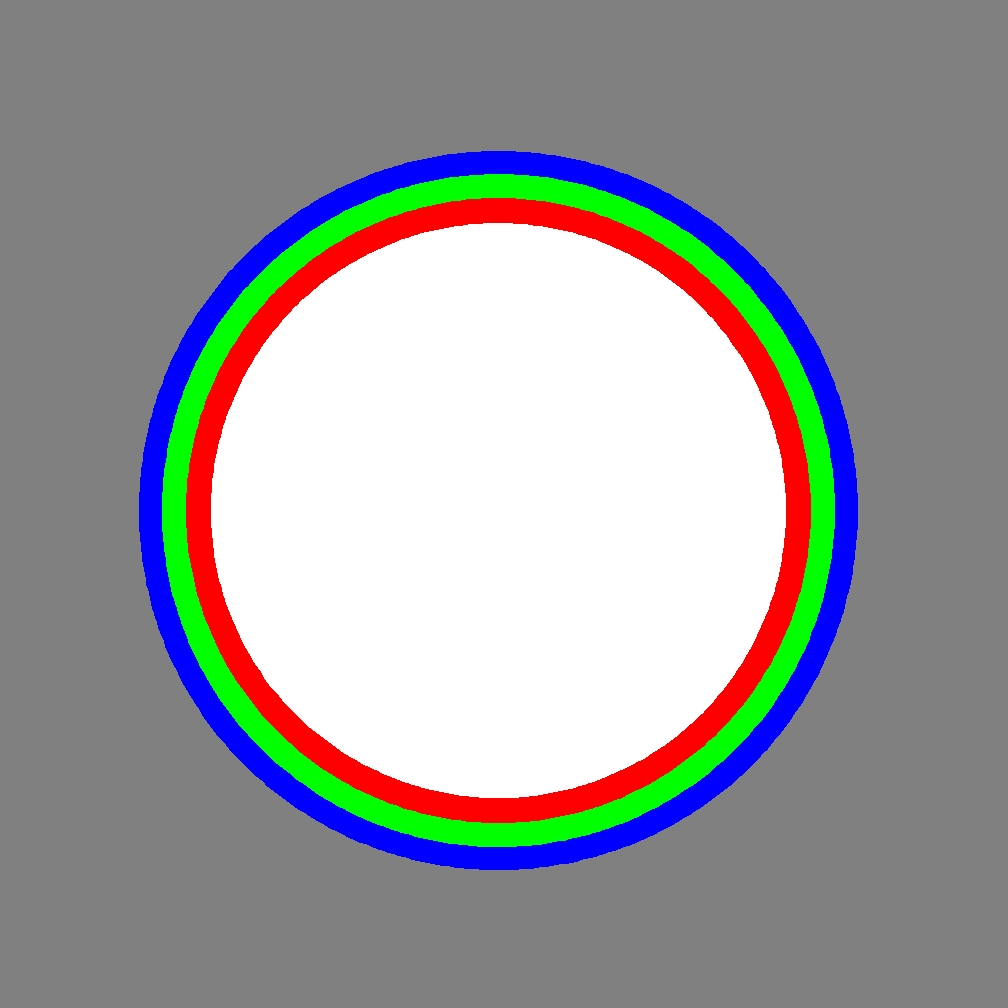
|
|
Circuit Breaker:
|
An electrical switch which protects an electrical circuit by automatically
opening when the circuit is overloaded. Differs from a fuse in that the
circuit breaker, after being tripped, can be reset, whereas the fuse
must be removed and replaced.
|
|
Color Temperature:
|
A measure of the color of white light. In fact, it is the
color of a "black body" heated up to that particular
temperature in the Kelvin (absolute) temperature scale.
A halogen incandescent lamp usually has a color temperature of
between 3000K and 3600K. Higher color temperatures are bluer than
are lower color temperatures. See:
Color Temperature – "White" Light Isn't White
|
|
Company Switch:
|
An electrical box used for connecting temporary lighting
equipment.
|
|
Count:
|
A Romanian title of nobility. Also, the length of time (in seconds)
it takes to complete a cue.
|
|
Crossfade:
|
A gradual transition from one set of channel levels to another. The
levels can be set in physical presets, as in a
preset board or in virtual cues, as in a computerized
memory console.
|
|
Cue (or State):
|
The predetermined intensities of the various lighting units at a
specific given time, as well as the levels of non-intensity
channels for devices such as moving lights, scrollers, and LED
fixtures.
|
|
Current:
|
The measure of the number of electrons passing a certain
point in one second. Measured in amperes.
|
|
Curtain Warmers:
|
A cue designed to light the grand drape (if used) or uninhabited stage
(if no front curtain is used) in order to give the audience something
at which to look before the performance begins, at intermission,
and after the performance ends.
|
|
Cyclorama (or Cyc):
|
A backcloth colored pale blue, gray, or white, used as a
sky backing. This was originally a curved
architectural plaster background to the stage. Many cloth
cycs are still curved, but flat cycs are more common today.
|
|
Dichroic:
|
A filter or reflector to which a layer of metal oxides is
added, causing it to transmit some wavelengths and reflect
others. Some lighting fixtures use dichroic reflectors,
which reflect light and transmit heat; this enables use of
a much brighter and therefore hotter lamp. Dichroic color
filters transmit only a particular color and reflect all
other wavelengths as well as heat; these are used in
moving lights, as they are the only color filters which
can withstand the intense temperatures within the fixtures.
|
|
Dimmer:
|
A device which regulates light intensity. Most dimmers do
this by electronically controlling the electricity transmitted to the lamp
(See: "SCR"). Fixtures with discharge lamps may have
mechanical dimmers (properly called "dowsers") which regulate the amount of light by
hiding it, similar to Venetian blinds. Older types of dimmers
include autotransformers and resistance dimmers.
|
|
Dimmer Hookup:
|
A spreadsheet listing each fixture in the show with all its relevant
information, including, color, template, accessories, dimmer,
circuit, channel, wattage, and purpose. The dimmer hookup is
arranged in order by dimmer number.
|
|
Dimmer Profile:
|
An indication, usually represented by a
graph, indicating how the dimmer will respond to a continuous
change in channel levels from 0%-100%. See
"Patching"
|
|
Direct Current:
|
Electricity flowing through a circuit in one direction only.
An example of this would be a battery-powered flashlight.
|
|
DMX:
|
Communications protocol standard, used primarily for theatre lighting systems,
for sending data from lighting consoles to dimmers, motorized lights, and
lighting accessory units such as color scrollers and fog machines. See
DMX512.
|
|
Dowser:
|
See: "Dimmer"
|
|
Dry Tech:
|
A technical rehearsal in which the cues are run without actors.
|
|
Efficiency:
|
The ratio of emitted light to power consumed.
|
|
Field Angle:
|
The outer portion of the cone of light, in which the intensity does not fall below 10% of maximum.
See Photometrics.
|
|
Fly System:
|
A mechanical system for bringing in (moving closer to the floor) or taking out
(moving farther from the floor) battens and tabs. Common types of fly systems include
hemp, counterweight, and electrical winches.
See the section on fly systems.
|
|
Foot Candle:
|
Photometric intensity unit: lumen per square foot.
|
|
Frequency:
|
The number of waves that pass a given point in space during a specific time interval.
Frequency is usually measured in hertz (symbol: Hz), on hertz being one cycle/second.
Light travels at such a high speed that it is measured in terahertz (symbol: THz). One
THz is 1012 Hz.
|
|
Gel:
|
Plastic medium used to change the color of a beam of light.
Originally made of animal gelatin. Major manufacturers
include Apollo, GAM, Lee, and Rosco.
|
|
Gobo (or Template):
|
Metal or glass (or, in rare, very specific, situations, plastic) pattern used in ellipsoidal reflector spotlights to project an image.
|
|
Grand Drape (or Act Curtain):
|
The main curtain in a proscenium theatre. Usually paired with the "Grand Valence".
|
|
Ground (or Earth):
|
A direct electrical connection to the Earth. Electricity always takes
the path of least resistance. In the event that a stage lighting fixture
(or other piece of equipment) has faulty electrical insulation, leading to
dangerous voltage passing through the metal outer body, proper grounding
will drain that voltage into the Earth. The circuit breaker will
pop, but you won't.
|
|
Ground Row:
|
A row of lighting fixtures placed (usually) downstage of a backdrop
in order to light it. The low-lying row of scenery that often masks
the electrics ground row is also referred to as a "ground row".
|
|
Halogen Lamp (or Tungsten Halogen):
|
A lamp whose envelope is filled with halogen rather than
inert gas. In a non-halogen lamp, as the filament
heats up, pieces of it evaporate and are deposited on the inside of
the bulb, changing the color temperature of the lamp. In
a halogen lamp, these pieces combine with the gas and are
redeposited on the filament. This could make for far
greater lamp life but instead has been used to
enable manufacture of brighter, hotter and smaller bulbs.
Due to the heat ordinary glass may not be used for the
envelope; instead, a quartz alloy is used. This collects
grease and therefore should not be touched; grease from
the finger remains on the bulb and causes it to weaken
when hot. It is easy to tell who touched the bulb and
caused a greatly-reduced lamp life; the perpetrator's
fingerprint will be clearly etched on the glass. If the
envelope is inadvertently touched, it can be wiped clean
with alcohol.
Non-halogen lamps are often referred to as "incandescent",
but this is less than accurate, as halogen lamps also use
the principle of incandescence (see "Lamp").
|
|
Hazer:
|
A device which produces a light haze which
hangs in the atmosphere, causing beams of light to become
visible. Depending on the individual unit, may be
manually controlled or controlled, via DMX, by the console.
|
|
Hue:
|
That property of light by which the color of an object is
classified as red, blue, green, or yellow in reference to
the spectrum.
|
|
Incandescent:
|
Incandescent light is formed by heating a filament to the point at
which it glows. Most theatrical light, including that generated by
tungsten halogen lamps, is incandescent.
|
|
Inert Gas:
|
A gas which does not undergo chemical reactions under a set of given conditions .
|
|
Instrument Schedule:
|
A spreadsheet listing each fixture in the show with all its relevant
information, including, color, template, accessories, dimmer,
circuit, channel, wattage, and purpose. The instrument schedule is
arranged in order of hanging position and fixture number.
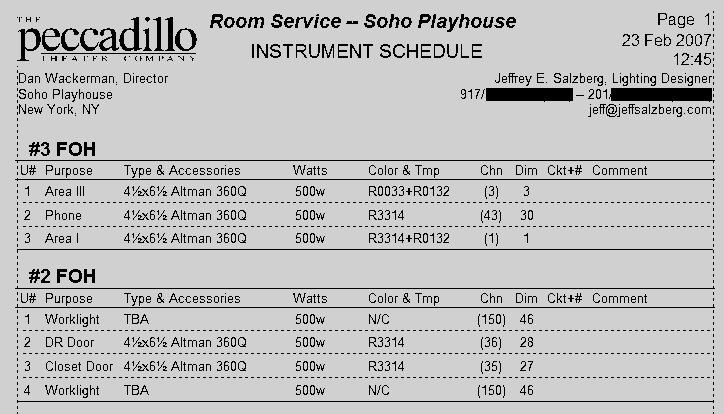
|
|
Iris:
|
A mechanical device used to vary the diameter of the light
from an ellipsoidal reflector spotlight. In most cases,
the iris can easily be inserted into or removed from the fixture.

|
|
Lamp:
|
That which is referred to commonly as a "light bulb". The lamp consists of three parts:
- Filament: The internal
coil of wire which heats up as electricity is passed
through it and thereby glows and produces light. This
process is called incandescence.
- Base: The metal part
of the lamp that connects it to the fixture. There are
many types of base, including prefocus, bayonet, screw,
and two-pin.
- Bulb: The glass envelope
that surrounds and contains the filament.
|
|
LED:
|
Light Emitting
Diode.
Increasingly used as theatrical light sources as growing levels of
light efficiency are reached and control technology is improved.
LEDs are manufactured in
various colors, most commonly red and green.
White LEDS are actually blue with a phosphor envelope
which transforms blue light to white. LEDs use far less power per
lumen than incandescent or halogen sources, and produce far less
heat, but are more expensive and complex to build and produce a
very narrow spectrum of light. Modern LED theatrical fixtures use a
combination of colors (at minimum, red, green, and blue, although
many fixtures also have an amber channel and some have as many as
seven colors) to provide built-in additive color mixing. Because LEDs
provide a narrow color spectrum, the output of these fixtures often
yield unsatisfactory results when lighting human skin.
|
|
Leg:
|
A vertical masking unit place at the side of the stage in order to
mask the offstage area from the audience.
|
|
Light Plot:
|
A drawing or drawings showing the location of each fixture,
its fixture type, color, channel, dimmer, and focus.
|
|
Lightwright TM:
|
A computer program used to generate instrument schedules,
channel hookups, and other paperwork from a single
database/spreadsheet with error-checking and many
lighting-specific data entry shortcuts. In the American
professional theatre, Lightwright is the industry
standard lighting database program.
|
|
Lumen:
|
A measure of light intensity produced by a light source. Lumens are
a measurement of light generated by a source, as opposed to
footcandles (or lux) which measure the light received at the target,
over a given area and are affected by the optics of the fixture as well
as by the throw distance.
|
|
Mask:
|
To hide from the audience's view, often with black velour
curtains or other scenic elements. These elements are collectively
referred to as "masking".
|
|
Multiplexing:
|
The combining of several different message signals or data streams
into one signal over a shared medium.
|
|
Nuremberg Light:
|
A light hitting the performer from almost straight below, an uplight.
So called because Albert Speer used them in the Nazi rallies at
Nuremberg.
|
|
Paper Tech:
|
A production meeting, before the first technical rehearsal, in which
the stage manager, the designers, and the director discuss the
various cues and the general flow of the production, without
actually running the cues.
|
|
Park:
|
A command which causes a specific channel or dimmer to remain at a
given setting regardless of the level at which it is set in submasters
and cues. An example of this would be a fixture which has been knocked
out of focus and is shining into the audience's eyes, and therefore might
be parked at 0% until such time as it can be refocused.
|
|
Photometrics:
|
The data used to calculate the field size and intensity of a lighting fixture.
|
|
Pilaster:
|
A slightly-projecting column built into or applied to the face of a
wall. Most commonly flattened or rectangular in form, pilasters can
also take a half-round form or the shape of any type of column.
(Definition courtesy of Wikipedia). Pilasters are often found on
either side of a proscenium arch.
|
|
Pilaster Line (or "Plaster Line"):
|
An imaginary line between the upstage-most points of the SL and SR
pilasters. This line is typically the zero-point from which DS/US
measurements are based.
|
|
Pipe Clamp (or C-Clamp):
|
 The clamp that attaches a lighting fixture to the hanging
position. In the US, these are usually made of malleable iron;
in other parts of the world (notably the UK) they are made
of more substantial material.
The clamp that attaches a lighting fixture to the hanging
position. In the US, these are usually made of malleable iron;
in other parts of the world (notably the UK) they are made
of more substantial material.

|
|
Power (or Wattage):
|
The amount of electrical "work" being performed. Measured
in watts.
|
|
Practical:
|
A prop electrical device (usually a lighting fixture such
as a chandelier or table lamp) that actually functions.
|
|
Proscenium (or Proscenium Arch):
|
The opening in the wall which separates the stage from the seating area.
Often framed on either side by pilasters.
|
|
Reflector:
|
- A mirror (usually curved) in the rear of a lighting
fixture.
- Anything used to reflect light.
|
|
Resistance:
|
The degree to which a substance opposes the passage of
electricity. Measured in ohms.
|
|
Saturation:
|
The degree of purity of a color; the degree of freedom from
admixture with other colors. Also known as chroma.
|
|
Scrim:
|
An open weave fabric which appears opaque when lit from the front,
but turns transparent when objects behind it are lit (Note that a
scrim is approximately 50% air, so when frontlighting it, care must
be taken so the light passing through the scrim does not illuminate
people or objects behind it.) Scrims are most often found in either
black or white, but they are available in many colors and can even
be painted (although the painter must be careful not to allow the
paint to obscure the holes in the weave). The act of fading down
the frontlight on a scrim while raising the intensity of the light
on the objects behind it – therefore revealing those objects
to the audience – is called a "bleed-through," or a "scrim-through".
|
|
Scroller:
|
 Color changing device placed on a lighting fixture, made of two
cylinders with a long strip of color filters rolled around
them. Digital signals control the movement of the cylinders
to determine which piece of the strip is placed before
the light.
Color changing device placed on a lighting fixture, made of two
cylinders with a long strip of color filters rolled around
them. Digital signals control the movement of the cylinders
to determine which piece of the strip is placed before
the light.
|
|
Shade:
|
A color with a low value. It is usually created by a
mixture of one or more hues with black.
|
|
Shin Busters:
|
Lighting instruments placed at the sides of the stage at or
near floor level, frequently used in dance.
|
|
Sightline:
|
The offstage-most edge of what can be seen, onstage, from the audience.
|
|
Silicon Controlled Rectifier (or SCR):
|
An electronic device, similar in function to a transistor,
but can withstand higher voltages. It behaves as a
super-swift valve, opening and shutting to control the
amount of electricity delivered to the lamp. Perhaps the most
common technology used for dimming traditional theatrical lighting.
|
|
Special:
|
One or more fixtures focused on a limited area, usually not part of a
wash.
|
|
Spectrum:
|
In lighting, the band of colors produced when white light is
passed through a prism, comprised of red, orange, yellow,
green, blue, indigo, and violet.
|
|
Stage Circuit (or Circuit):
|
The wiring which connects the fixture (usually via an outlet)
to the patch panel or dimmer.
|
|
State:
|
See "Cue"
|
|
Tab:
|
See "Batten"
|
|
Tension Grid:
|
(Also known as "Tension Wire Grid" or "TWG")
Provides walking surface over performance area allowing
lighting from any position overhead. Made of interwoven 1/8"
aircraft cable.
|
|
|

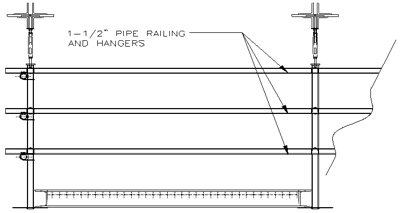

[Tension grid images courtesy of Peter Albrecht
Company.]
|
|
Throw:
|
The distance from the fixture to the performer or scenic unit being lighted.
|
|
In the example below, the fixture has a
beam angle of 16° and a field
angle of 40°. The throw is
12'. The beam width is 3'-4.5" and the field width is 8'-9".
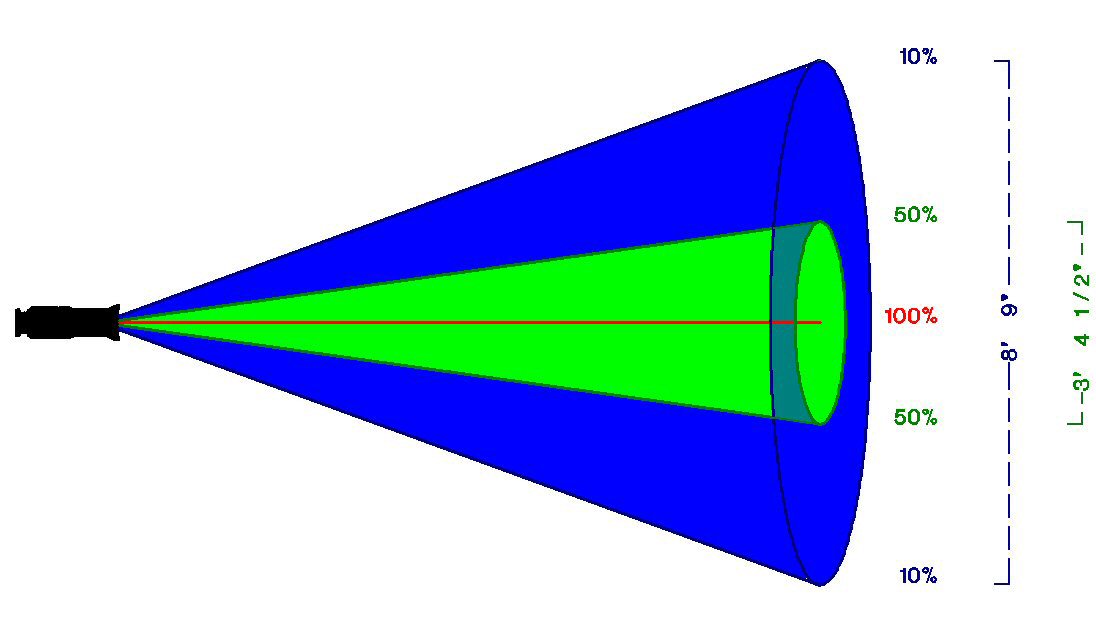
|
|
Thrust Stage (or "Three-Quarter" Stage):
|
A stage with the audience around it on three sides.
|
|
Tie Line:
|
(Also known as "trick" line). Cotton rope, usually black, approximately
1/8" in diameter. Uses include tying up cables and draperies.
|
|
Tint:
|
A color with a high value is referred to as a tint.
This is usually achieved by mixing a hue with either
white pigment or white light.
|
|
Tone:
|
A color of middle value, neither a shade nor a tint.
|
|
Transmission:
|
The degree to which a medium passes light, measured in
terms of the percentage of light which is transmitted.
|
|
Trim:
|
As a verb, refers to the act of setting the height of an overhead
masking piece or electric batten, or the distance from centerline
of a leg or other masking unit.
As a noun, refers to the position set by the act of trimming.
|
|
Twist-Lock®:
|
A registered trademark of Hubbell, Incorporated, although the term
(usually spelled "twistlock") is used as a generic descriptor for
a specific type of locking connector
regardless of manufacturer. These connectors have curved blades, and
when the male connector is inserted into the receptacle and twisted,
the two connectors are locked together. Note that there are several
different configurations of Twist-Locks, which are not interchangeable.
|
|
Twofer:
|
An adaptor allowing two fixtures to be plugged into one circuit.
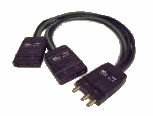
|
|
Universe:
|
Refers to a network of systems tied together using
one system of control information. Most commonly used in relation to
DMX-512, but can refer to other networked systems such as sound or video.
Each universe that a control console addresses uses a separate signal output
and is directed through a separate set of cables to lighting devices. Multiple
universes allow a single console to control more than 512 paths of information;
many modern consoles provide anywhere from 2-8 universes (1024-4096
addresses) and can be upgraded to handle far more. (Courtesy of Mark Thomason)
|
|
Value:
|
The relative lightness or darkness of a color.
Pale blue has a high value, and dark blue has a low value.
|
|
Volt:
|
The unit of electrical pressure or electromotive force.
|
|
Wash:
|
Multiple fixtures which, when used together, cover the entire
performing area with a single color from the
same direction.
|
|
Watt:
|
The unit of electrical power.
|
|
Wavelength:
|
The distance between any two corresponding points on successive waves.
|
|
X-Ray (or Borderlight):
|
A striplight, hung overhead, usually running the entire width of
the batten.
|
|
Zoom:
|
A zoom lens has the ability to vary its focal length
(and thus the field and beam angles). When a zoom lens is
set to its narrowest setting, the field is brighter than
that of the widest setting.
|